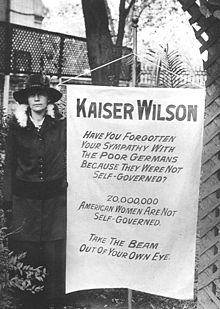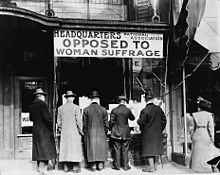Suffragettes

As suffragettes (of English / French suffrage , suffrage ') referred to the early 20th century (mainly from 1903 to 1928) more or less organized feminists in the United Kingdom and the United States (here was the self-chosen name actually suffragist ), the front especially with passive resistance and with disruptions of official events up to hunger strikes for a general women's suffrage . The suffragette movement was predominantly carried out by women from the middle class .
The term suffragettes was originally coined by the English press in order to demean the suffrage activists, but was successfully co-opted by them for themselves. In the aftermath of the movement, the term was once again used pejoratively for committed women's rights activists, similar to the pejorative meaning of the term “ Emanze ” today .
story
The suffragettes in Great Britain evolved from opponents of the Contagious Diseases Acts , the laws from 1864 to 1869 on the compulsory examinations of prostitutes to prevent sexually transmitted diseases. Their commitment led to the legal decrees being repealed in 1883 and finally repealed in 1886. The success of the campaign radicalized the advocates of women's suffrage, who organized themselves and developed new methods of political protest.
At the same time, Kate Sheppard campaigned for women's suffrage in New Zealand , which was introduced there in 1893 as the first country in the world.
In 1903, Emmeline Pankhurst founded the Women's Social and Political Union in Great Britain , a civic women's movement that attracted attention in the years that followed through public protests, political demonstrations and hunger strikes. Her daughter Christabel Pankhurst was one of the leading suffragettes in the struggle for women's suffrage in Britain. Another taboo breach by the suffragettes was demonstrative smoking in public, which at the time was considered an exclusively male privilege and, exercised by women, was perceived as presumptuous. On February 9, 1907, around 3,000 suffragettes gathered and peacefully demonstrated for women to vote.
After the failure of a legislative initiative aimed at expanding women's rights in 1910, shop windows were broken into, large country estates were set on fire, and public buildings were bombed, including Westminster Abbey . On November 18, 1910, also known as Black Friday , bloody arguments broke out in front of the British House of Commons after a speech by Prime Minister Herbert Henry Asquith . Eighty armed women were arrested. The English composer Ethel Smyth was also an active suffragette for a while. In 1910 she wrote the March of the women (text: Cicely Mary Hamilton ) for the London demonstrations , which, as the hymn of the suffragette movement, was an essential element of the cohesion of the women demonstrating and was first heard on Pall Mall in January 1911 . Part of Ethel Smyth's memoir is an important eyewitness account of the period. The conductor Thomas Beecham , who was very supportive of the women, also reports about it in his memoirs, as does the painter Moritz Coschell , who contributed a drawing entitled "Emmeline Pankhurst and her daughter Christabel in prison" for the Berliner Illustrirte Zeitung in 1913. Another friend and supporter of the aspirations for emancipation was the writer George Bernard Shaw . On March 1, 1912, 150 suffragettes, armed with hammers and stones, destroyed 270 windows in the shopping district of London's West End. This resulted in the arrest of 220 women. At the Epsom Derby in 1913, Emily Davison threw herself in protest in front of George V's horse and died a few days later. The First World War temporarily halted the UK suffrage campaign. After the end of the First World War in 1918, women aged 30 and over who owned real estate were given the right to vote.
Alice Paul and Lucy Burns , on the other hand, led a series of protests in the United States against US President Woodrow Wilson, who was dubbed "Emperor Wilson" . Numerous members of the National Woman's Party (NWP), founded by Alice Paul in June 1916, were imprisoned under questionable conditions from 1917 to 1919, leading to hunger strikes and force-feeding.
As a result of the war-related labor shortage, women in both the USA and Great Britain became more firmly anchored in many areas of public life, which ultimately led to the general acceptance of women's suffrage.
With the implementation of women's suffrage in the USA in 1919 and 1920 ( 19th Amendment to the United States Constitution ) and in Great Britain from July 2, 1928, the movement achieved its goals. In some other countries the right to vote for women was achieved earlier and mostly non-violently: Active New Zealand in 1893, active Australia in 1906, Finland in general, 1913 Norway in general, 1915 Denmark in general, Netherlands passive, 1917 Russia in general, 1918 Austria in general, 1918 Germany in general , 1918 Poland in general.
Through the film Mary Poppins with the song Sister Suffragette , suffragettes became known to children from 1964 to the present day.
See also
literature
- Linda Ford: Iron Jawed Angels. The suffrage militancy of the National Woman's Party . University Press of America, Lanham, Md. 1991, ISBN 0-8191-8205-2 (Work on the US Movement).
- Beatrix Geisel: Class, Gender and Law. Comparative socio-historical study (writings on equality of women; vol. 16). Nomos Verlagsgesellschaft, Baden-Baden 1997, ISBN 3-7890-4933-6 (plus dissertation, University of Frankfurt / M. 1996).
- Jana Günther: Suffragettes. Media staging and symbolic politics . In: Paul Gerhard (ed.): The century of pictures. 1900 to 1949 . Vandenhoeck & Ruprecht, Göttingen 2009, pp. 108-115, ISBN 978-3-525-30011-4 .
- Jana Günther: The political staging of the suffragettes in Great Britain. Forms of protest, violence and symbolic politics of a women's movement . fwpf-Verlag, Freiburg / B. 2006, ISBN 978-3-939348-04-7 (also diploma thesis, University of Humboldt University Berlin 2005).
- Michaela Karl : “We demand half the world!” The struggle of the English suffragettes for women's suffrage . Fischer Taschenbuchverlag, Frankfurt / M. 2009, ISBN 978-3-596-18355-5 .
- Antonia Meiners (Ed.): The Suffragettes. They wanted to vote - and were laughed at . Elisabeth Sandmann Verlag, Munich 2016, ISBN 978-3-945543-13-9 .
- Melanie Phillips: The Ascent of Woman. A History of the Suffragette Movement and the ideas behind it . Abacus Books, London 2004, ISBN 0-349-11660-1 (EA London 2003).
- Hannelore Schröder: Unruly, rebels, suffragettes. Feminist awakening in England and Germany (Philosophinnen; Vol. 12). Ein-Fach-Verlag, Aachen 2001, ISBN 3-928089-30-7 .
Movie
- Michèle Dominici (Director): The Suffragettes. Rebellious, combative = Les suffragettes. Ni paillassons, ni prostituées . Paris 2011 (documentation for Arte )
- Katja von Garnier (Director): Alice Paul - The way into the light . USA, 2004.
- Sarah Gavron (Director): Suffragette - actions instead of words . UK, 2015.
- In the US series Cold Case , Suffragettes are about the problems of a young woman who wanted to stand up for her rights.
Web links
- Biographies (English)
- Radical suffragettes. A portrait on the 75th anniversary of the death of the female suffrage campaigner Emmeline Pankhurst
- Sally Roesch Wagner: The Untold Story of the Iroquois Influence on Early Feminists
Individual evidence
- ^ A b Frank Patalong: Civil War of the Sexes. Spiegel Online, March 4, 2013, accessed March 20, 2013 .
- ↑ Kate Frye: Kate Frye's Diary: The Mud-March 9 February. Retrieved February 6, 2017 .
- ↑ Ulrike Rückert: We wanted to raise public awareness. Deutschlandradio, November 18, 2010, accessed on May 8, 2014 .
- ↑ Thomas Beecham: A Mingled Chime. Leaves from an Autobiography . Hutchinson, London a. a. 1944.
- ↑ Glass-Smashing for Votes! Suffragettes as Window-Breakers. Illustrated London News, March 9, 1912, accessed March 15, 2014 .

